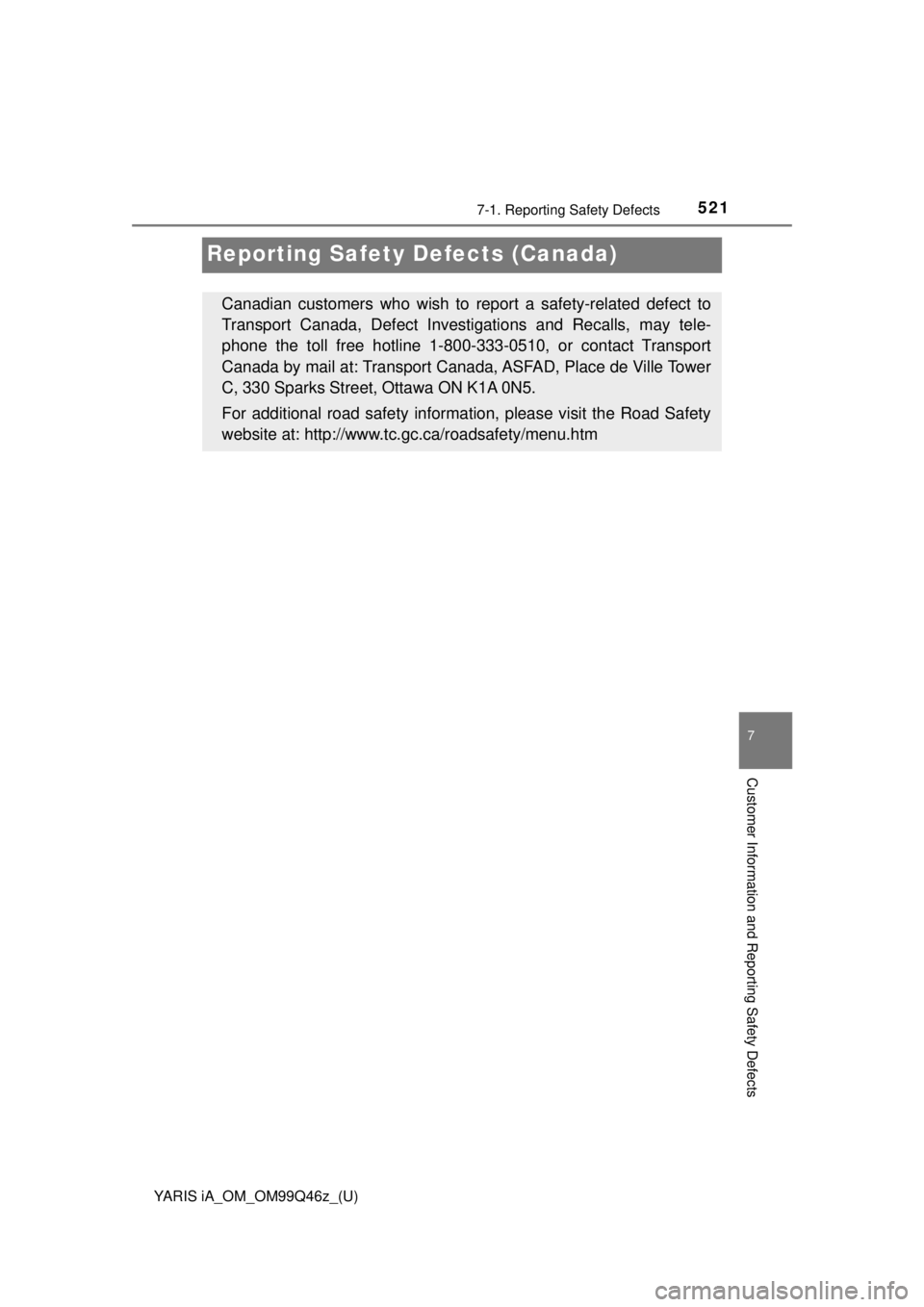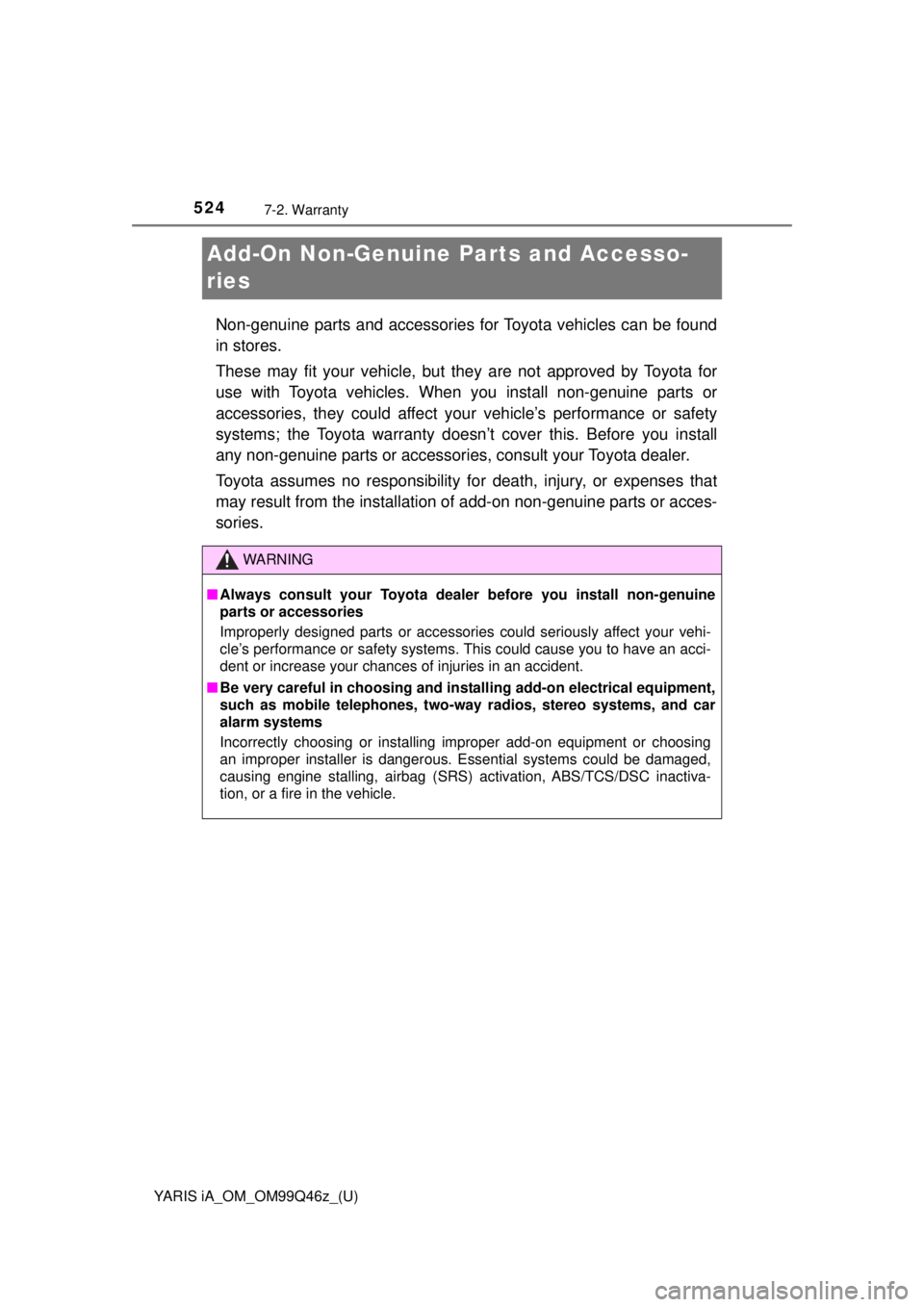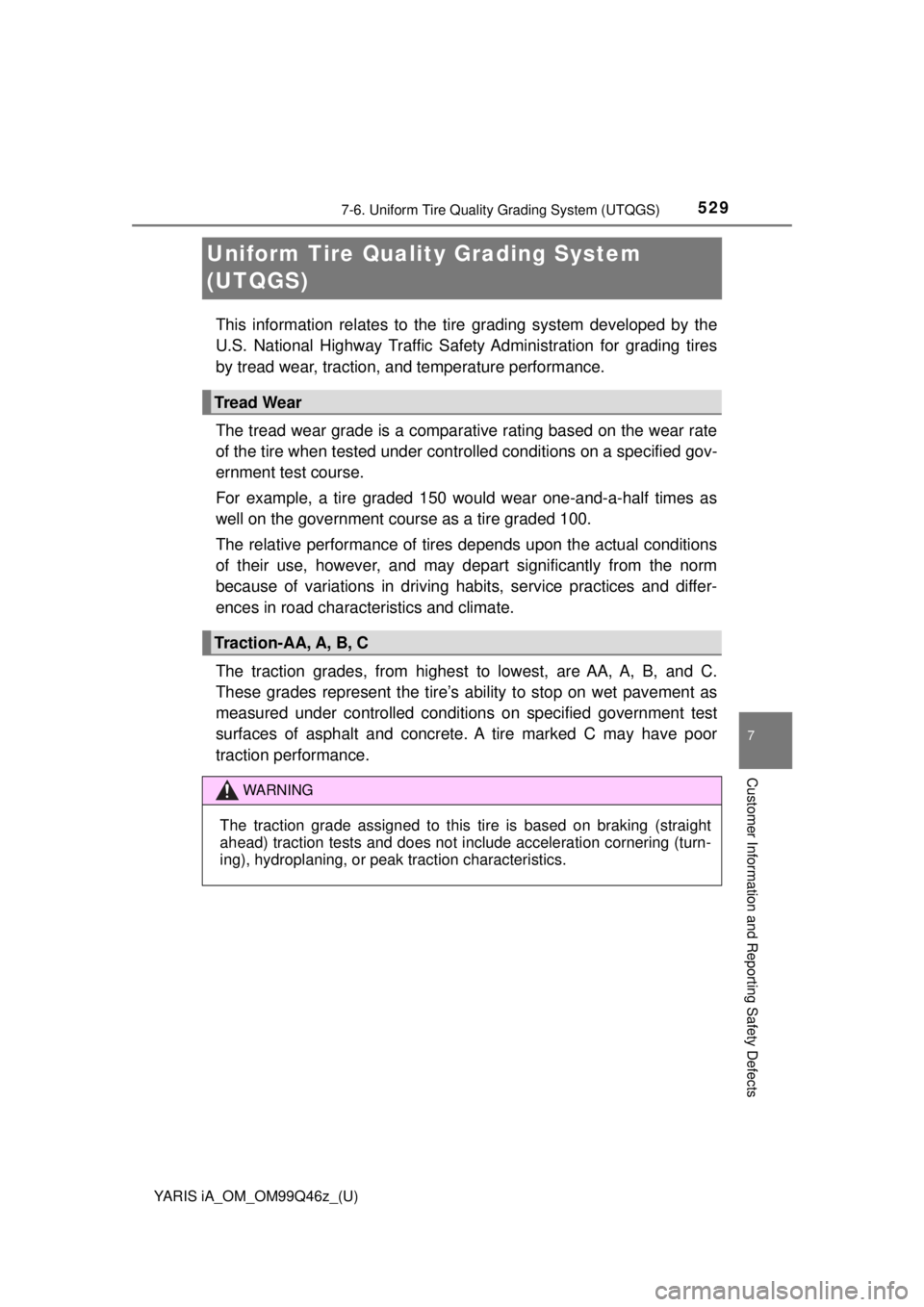TOYOTA YARIS iA 2018 Owners Manual (in English)
Manufacturer: TOYOTA, Model Year: 2018, Model line: YARIS iA, Model: TOYOTA YARIS iA 2018Pages: 576, PDF Size: 5.5 MB
Page 521 of 576

521
YARIS iA_OM_OM99Q46z_(U)
7-1. Reporting Safety Defects
7
Customer Information and Reporting Safety Defects
Reporting Safety Defects (Canada)
Canadian customers who wish to report a safety-related defect to
Transport Canada, Defect Investig ations and Recalls, may tele-
phone the toll free hotline 1-800-333-0510, or contact Transport
Canada by mail at: Transport Canada, ASFAD, Place de Ville Tower
C, 330 Sparks Street, Ottawa ON K1A 0N5.
For additional road safety information, please visit the Road Safety
website at: http://www.tc.gc.ca/roadsafety/menu.htm
Page 522 of 576

522
YARIS iA_OM_OM99Q46z_(U)
7-2. Warranty
Warranties for Your Toyota
●New Vehicle Limited Warranty
● Powertrain Limited Warranty
● Safety Restraint System Limited Warranty
● Anti-perforation Limited Warranty
● Federal Emission Control Warranty/California Emission Control
Warranty
• Emission Defect Warranty
• Emission Performance Warranty
● Emission Control Warranty
● Replacement Parts and Accessories Limited Warranty
● Tire Warranty
Warranty information varies depending on the country. Refer to the “Owner’s
Warranty Information Booklet” or “Owner’s Manual Supplement/Scheduled
Maintenance Guide” for detailed warranty information.
Page 523 of 576

523
YARIS iA_OM_OM99Q46z_(U)
7-2. Warranty
7
Customer Information and Reporting Safety Defects
Outside the United States/Canada
Government regulations in the United States/Canada require that
automobiles meet specific emission regulations and safety standards.
Therefore, vehicles built for use in the United States/Canada may dif-
fer from those sold in other countries.
The differences may make it difficult or even impossible for your vehi-
cle to receive satisfactory servici ng in other countries. We strongly
recommend that you NOT take your Toyota outside the United States/
Canada.
United States
However, in the event that you are moving to Canada permanently,
Toyota vehicles built for use in the United States could be eligible for
exportation to Canada with specific vehicle modifications to comply
with the Canadian Motor Vehicle Safety Standards (CMVSS).
Canada
However, in the event that you are moving to the United States per-
manently, Toyota vehicles built for use in Canada could be eligible for
exportation to the United States with specific vehicle modifications to
comply with the United States Federal Motor Vehicle Safety Standards
(FMVSS).
You may have the following problems if you do take your vehicle out-
side of the United States/Canada: • Recommended fuel may be unavailable. Any kind of leaded fuel or low-octane fuel will affect vehi cle performance and damage the
emission controls and engine.
• Proper repair facilities, tools, testing equipment, and replacement
parts may not be available.
Please refer to your Manufacturer’ s “Owner’s Warranty Information
Booklet” or “Owner’s Manual Supplement/Scheduled Maintenance
Guide” for more information.
The above is applicable for a permanent import/export situation and not
related to travelers on vacation.
Page 524 of 576

524
YARIS iA_OM_OM99Q46z_(U)
7-2. Warranty
Add-On Non-Genuine Parts and Accesso-
ries
Non-genuine parts and accessories for Toyota vehicles can be found
in stores.
These may fit your vehicle, but th ey are not approved by Toyota for
use with Toyota vehicles. When you install non-genuine parts or
accessories, they coul d affect your vehicle’s performance or safety
systems; the Toyota warranty doesn’t cover this. Before you install
any non-genuine parts or accessor ies, consult your Toyota dealer.
Toyota assumes no responsibility fo r death, injury, or expenses that
may result from the installation of add-on non-genuine parts or acces-
sories.
WARNING
■ Always consult your Toyota dealer before you install non-genuine
parts or accessories
Improperly designed parts or accessories could seriously affect your vehi-
cle’s performance or safety systems. This could cause you to have an acci-
dent or increase your chances of injuries in an accident.
■ Be very careful in choosing and inst alling add-on electrical equipment,
such as mobile telephones, two-w ay radios, stereo systems, and car
alarm systems
Incorrectly choosing or installing improper add-on equipment or choosing
an improper installer is dangerous. Essential systems could be damaged,
causing engine stalling, airbag (SRS ) activation, ABS/TCS/DSC inactiva-
tion, or a fire in the vehicle.
Page 525 of 576

525
YARIS iA_OM_OM99Q46z_(U)
7-3. Cell Phones
7
Customer Information and Reporting Safety Defects
Cell Phones Warning
WARNING
■Please comply with the legal regula tions concerning the use of com-
munication equipment in vehicles in your country
Use of any electrical devices such as cell phones, computers, portable
radios, vehicle navigation or other devices by the driver while the vehicle is
moving is dangerous. Dialing a number on a cell phone while driving also
ties-up the driver’s hands. Use of these devices will cause the driver to be
distracted and could lead to a serious accident. If a passenger is unable to
use the device, pull off the right-of-way to a safe area before use.
If use of a cell phone is necessary despite this warning, use a hands-free
system to at least leave the hands free to drive the vehicle. Never use a cell
phone or other electrical devices while the vehicle is moving and, instead,
concentrate on the full-time job of driving.
Page 526 of 576

526
YARIS iA_OM_OM99Q46z_(U)
7-4. Event Data Recorder
Event Data Recorder (U.S.A. and Canada)
This vehicle is equipped with an event data recorder (EDR). The main
purpose of an EDR is to record, in certain crash or near crash-like sit-
uations, such as an air bag deploym ent or hitting a road obstacle, data
that will assist in understanding how a vehicle’s systems performed.
The EDR is designed to record data related to vehicle dynamics and
safety systems for a short period of time, typically 30 seconds or less.
The EDR in this vehicle is designed to record such data as:
● How various systems in your vehicle were operating;
● Whether or not the driver and passenger safety belts were buckled/
fastened;
● How far (if at all) the driver was depressing the accelerator and/or
brake pedal; and,
● How fast the vehicle was traveling.
These data can help provide a be tter understanding of the circum-
stances in which crashes and injuries occur.
NOTE:
EDR data are recorded by your vehicle only if a non-trivial crash or
near crash-like situation occurs; no data are recorded by the EDR
under normal driving conditions a nd no personal data (e.g., name,
gender, age, and crash location) are recorded. However, other par-
ties, such as law enforcement, could combine the EDR data with the
type of personally identifying data routinely acquired during a crash
investigation.
To read data recorded by an EDR, special equipment is required, and
access to the vehicle or the EDR is needed. In addition to the vehicle
manufacturer, other parties, such as law enforcement, that have the
special equipment, can read the inform ation if they have access to the
vehicle or the EDR.
Toyota will not disclose any of the data recorded in an EDR to a third
party unless:
● A written agreement from the vehicle owner or the lessee is
obtained
● Officially requested by the police or other law enforcement authori-
ties
● Used as a defense for Toyota in a lawsuit, claim, or arbitration
● Ordered by a judge or court
Page 527 of 576

YARIS iA_OM_OM99Q46z_(U)
5277-4. Event Data Recorder
7
Customer Information and Reporting Safety Defects
However, if necessary Toyota will:
●Use the data for research on Toyota vehicle performance, including
safety.
● Disclose the data or the summarized data to a third party for
research purposes without disclosi ng vehicle or owner identification
information.
Page 528 of 576

528
YARIS iA_OM_OM99Q46z_(U)
7-5. Vehicle Data Recordings
Vehicle Data Recordings
Your Toyota is equipped with several sophisticated computers that will
record certain data, such as:• Engine speed
• Accelerator status
• Brake status
• Vehicle speed
• Shift position
The recorded data varies according to the vehicle grade level and
options with which it is equipped.
● Data usage
Toyota may use the data recorded in these computers to diagnose
malfunctions, conduct research and development, and improve
quality.
Toyota will not disclose the recor ded data to a third party except:
• With the consent of the vehicle owner or with the consent of the lessee if the vehicle is leased
• In response to an official request by the police, a court of law or a
government agency
• For use by Toyota in a lawsuit
• For research purposes where the data is not tied to a specific vehicle or vehicle owner
Page 529 of 576

529
YARIS iA_OM_OM99Q46z_(U)
7-6. Uniform Tire Quality Grading System (UTQGS)
7
Customer Information and Reporting Safety Defects
Uniform Tire Qualit y Grading System
(UTQGS)
This information relates to the tire grading system developed by the
U.S. National Highway Traffic Safety Administration for grading tires
by tread wear, traction, and temperature performance.
The tread wear grade is a comparative rating based on the wear rate
of the tire when tested under controlled conditions on a specified gov-
ernment test course.
For example, a tire graded 150 would wear one-and-a-half times as
well on the government course as a tire graded 100.
The relative performance of tires depends upon the actual conditions
of their use, however, and may d epart significantly from the norm
because of variations in driving habits, service practices and differ-
ences in road characteristics and climate.
The traction grades, from highest to lowest, are AA, A, B, and C.
These grades represent the tire’s ability to stop on wet pavement as
measured under controlled conditio ns on specified government test
surfaces of asphalt and concrete . A tire marked C may have poor
traction performance.
Tread Wear
Traction-AA, A, B, C
WARNING
The traction grade assigned to this tire is based on braking (straight
ahead) traction tests and does not include acceleration cornering (turn-
ing), hydroplaning, or peak traction characteristics.
Page 530 of 576

530
YARIS iA_OM_OM99Q46z_(U)
7-6. Uniform Tire Quality Grading System (UTQGS)
The temperature grades A (the highes t), B, and C, represent the tire’s
resistance to the generation of heat and its ability to dissipate heat
when tested under controlled conditions on a specified indoor labora-
tory test wheel.
Sustained high temperature can cause the material of the tire to
degenerate and reduce tire life, and excessive temperatures can lead
to sudden tire failure.
Grade C corresponds to a level of performance which all passenger
vehicle tires must meet under the Federal Motor Vehicle Safety Stan-
dard No. 109. Grades B and A represent higher levels of performance
on the laboratory test wheel than the minimum required by law.
These grades will be added to the sidew alls of passenger vehicle tires
over the next several years according to a schedule established by
the NHTSA and the tire manufacturers.
The grade of tires available as st andard or optional equipment on Toy-
ota vehicles may vary with respect to grade.
ALL PASSENGER VEHICLE TIRES MUST CONFORM TO THESE
GRADES AND TO ALL OTHER FE DERAL TIRE-SAFETY REQUIRE-
MENTS.
Temperature-A, B, C
WARNING
■Keep your vehicle’s tires properly inflated and not overloaded
Driving with improperly inflated or overloaded tires is dangerous. Exces-
sive speed, underinflation, or excessive loading, either separately or in
combination, can cause heat buildup and possible tire failure. The tem-
perature grade for this tire is established for a tire that is properly
inflated and not overloaded.